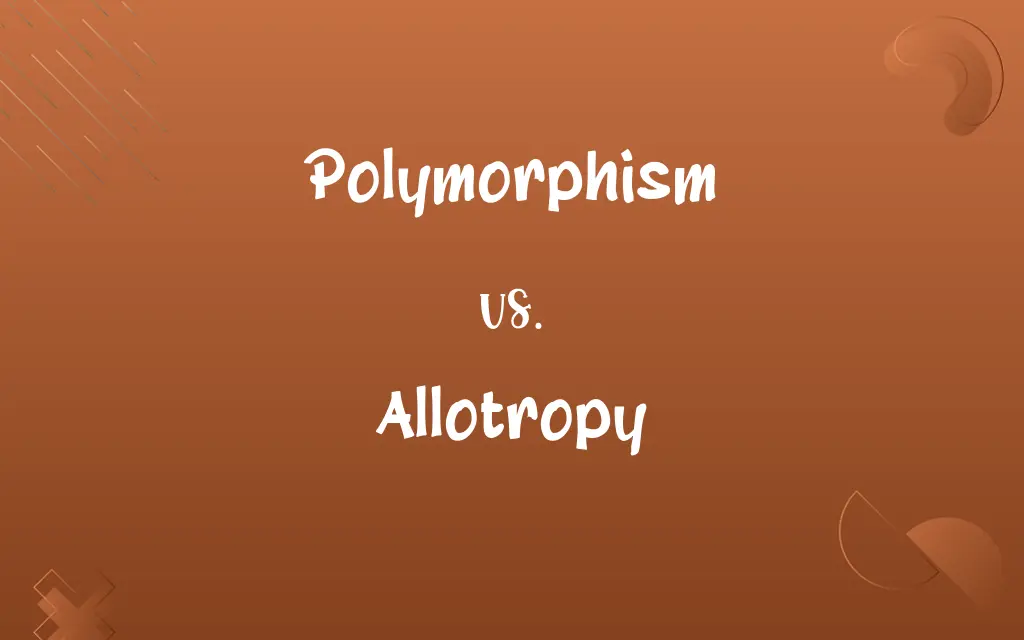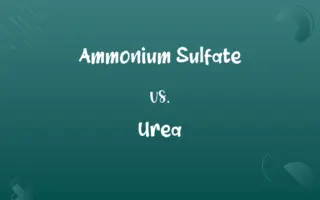Polymorphism vs. Allotropy: Know the Difference

By Shumaila Saeed || Published on January 3, 2024
Polymorphism refers to variations in form within a species under different conditions, while allotropy refers to different physical forms of the same element.

Key Differences
Polymorphism refers to the ability of a substance to exist in more than one form or crystal structure. This phenomenon is observed in various materials, including crystals and molecules. On the other hand, Allotropy specifically pertains to elements, describing the existence of two or more different forms of the same element in the same physical state. These forms differ in their physical and sometimes chemical properties.
Shumaila Saeed
Jan 03, 2024
Polymorphism is a term widely used in many fields, including biology, where it indicates the occurrence of different types or forms of species. In contrast, Allotropy is a term used exclusively in chemistry and physics, referring to the different structural modifications of an element. The allotropes of an element have different molecular arrangements but are composed of the same type of atoms.
Shumaila Saeed
Jan 03, 2024
Polymorphism can be observed in compounds where the atoms or molecules can be packed in different ways, leading to different physical properties. Allotropy, in comparison, is a property exclusive to chemical elements, not compounds, and results in different physical forms like graphite and diamond for carbon.
Shumaila Saeed
Jan 03, 2024
In Polymorphism, the changes in structure often lead to different melting points, solubilities, and densities. Allotropy also results in variations in such physical properties, but these changes are a result of different bonding arrangements between the atoms of the same element.
Shumaila Saeed
Jan 03, 2024
In essence, Polymorphism is about the same compound exhibiting different structures, while Allotropy is about the same element existing in different forms. Both phenomena showcase nature's versatility in the microscopic world of atoms and molecules.
Shumaila Saeed
Jan 03, 2024
ADVERTISEMENT
Comparison Chart
Definition
Variation in form within a species or compound
Different physical forms of the same element
Shumaila Saeed
Jan 03, 2024
Scope
Broad, applicable in biology and chemistry
Specific to chemistry and physics
Shumaila Saeed
Jan 03, 2024
Structural Change
Different molecular packings
Different atomic arrangements
Shumaila Saeed
Jan 03, 2024
ADVERTISEMENT
Polymorphism and Allotropy Definitions
Polymorphism
Different crystal forms of the same chemical substance.
The polymorphism of calcium carbonate results in both calcite and aragonite.
Shumaila Saeed
Dec 28, 2023
Allotropy
Different structural forms of the same element in the same physical state.
Carbon exhibits allotropy, existing as both diamond and graphite.
Shumaila Saeed
Dec 28, 2023
Polymorphism
Genetic variation within a population, upon which natural selection operates.
Blood types are an example of polymorphism in human genetics.
Shumaila Saeed
Dec 28, 2023
Allotropy
The phenomenon of an element existing in two or more different forms.
Oxygen's allotropy includes both O2 and ozone (O3).
Shumaila Saeed
Dec 28, 2023
Polymorphism
In materials science, the ability of a solid material to exist in more than one form or crystal structure.
Iron shows polymorphism, existing in different crystalline forms at various temperatures.
Shumaila Saeed
Dec 28, 2023
ADVERTISEMENT
Allotropy
Variation in physical and chemical properties of an element due to different atomic arrangements.
The allotropy of sulfur results in different molecular structures like rhombic and monoclinic sulfur.
Shumaila Saeed
Dec 28, 2023
Polymorphism
Different forms of the same species in biology.
The polymorphism in butterflies results in varied wing patterns.
Shumaila Saeed
Dec 28, 2023
Allotropy
The existence of an element in forms with different molecular structures in the same physical state.
Phosphorus shows allotropy, existing as white, red, and black phosphorus.
Shumaila Saeed
Dec 28, 2023
Polymorphism
The ability of a programming language to process objects differently based on their data type or class.
In programming, polymorphism allows the same function to process different types of objects.
Shumaila Saeed
Dec 28, 2023
Allotropy
Distinct forms of an element, identifiable by differences in physical properties.
Tin's allotropy causes it to change from white tin to gray tin under cold temperatures.
Shumaila Saeed
Dec 28, 2023
Polymorphism
(Biology) The occurrence of more than one form, as several alleles of a particular gene or winged and wingless forms of the same species.
Shumaila Saeed
Dec 27, 2023
Allotropy
The existence of two or more crystalline or molecular structural forms of an element that have different chemical or physical attributes.
Shumaila Saeed
Dec 27, 2023
Polymorphism
(Chemistry) Crystallization of a compound in at least two distinct forms. Also called pleomorphism.
Shumaila Saeed
Dec 27, 2023
Allotropy
(chemistry) A property, exhibited by some elements, of existing in multiple forms with different atomic structures.
Shumaila Saeed
Dec 27, 2023
Allotropy
The phenomenon of an element existing in two or more physical forms
Shumaila Saeed
Dec 27, 2023
Polymorphism
(biology) The coexistence, in the same locality, of two or more distinct forms independent of sex, not connected by intermediate gradations, but produced from common parents.
Shumaila Saeed
Dec 27, 2023
Polymorphism
(object-oriented programming) The feature pertaining to the dynamic treatment of data elements based on their type, allowing for an instance of a method to have several definitions. en
Shumaila Saeed
Dec 27, 2023
Polymorphism
The property of certain typed formal systems of allowing for the use of type variables and binders/quantifiers over those type variables; likewise, the property of certain expressions (within such typed formal systems) of making use of at least one such typed variable.
Shumaila Saeed
Dec 27, 2023
Polymorphism
(crystallography) The ability of a solid material to exist in more than one form or crystal structure; pleomorphism.
Shumaila Saeed
Dec 27, 2023
Polymorphism
(genetics) The regular existence of two or more different genotypes within a given species or population; also, variability of amino acid sequences within a gene's protein.
Shumaila Saeed
Dec 27, 2023
Polymorphism
The capability of assuming different forms; the capability of widely varying in form.
Shumaila Saeed
Dec 27, 2023
Polymorphism
(chemistry) the existence of different kinds of crystal of the same chemical compound
Shumaila Saeed
Dec 27, 2023
Polymorphism
(biology) the existence of two or more forms of individuals within the same animal species (independent of sex differences)
Shumaila Saeed
Dec 27, 2023
Repeatedly Asked Queries
How does polymorphism manifest in chemistry?
In chemistry, polymorphism is seen when a compound exists in more than one crystalline form.
Shumaila Saeed
Jan 03, 2024
Can polymorphism occur in programming?
Yes, polymorphism in programming allows objects to be processed differently based on their type or class.
Shumaila Saeed
Jan 03, 2024
What is polymorphism in biology?
Polymorphism in biology refers to the occurrence of different forms or types within a species.
Shumaila Saeed
Jan 03, 2024
What is an example of polymorphism in nature?
An example is the different wing patterns in butterflies of the same species.
Shumaila Saeed
Jan 03, 2024
What are common examples of allotropy?
Common examples include carbon existing as diamond and graphite.
Shumaila Saeed
Jan 03, 2024
Is allotropy limited to certain elements?
Allotropy is observed in many elements, but not all elements exhibit this property.
Shumaila Saeed
Jan 03, 2024
Can allotropy change the physical properties of an element?
Yes, different allotropes of an element can have distinct physical properties.
Shumaila Saeed
Jan 03, 2024
Is polymorphism related to genetic variation?
Yes, polymorphism can refer to genetic variation within a population.
Shumaila Saeed
Jan 03, 2024
Is polymorphism a rare occurrence?
No, polymorphism is quite common in both nature and materials.
Shumaila Saeed
Jan 03, 2024
Does allotropy have practical applications?
Yes, understanding allotropy is crucial in materials science and chemistry for various applications.
Shumaila Saeed
Jan 03, 2024
How does temperature affect allotropy?
Temperature changes can induce a transition between different allotropes of an element.
Shumaila Saeed
Jan 03, 2024
Can polymorphism affect drug efficacy?
Yes, different polymorphic forms of a drug can have different solubilities and efficacies.
Shumaila Saeed
Jan 03, 2024
Does polymorphism have evolutionary significance?
Yes, polymorphism can contribute to the evolutionary adaptation of species.
Shumaila Saeed
Jan 03, 2024
What is allotropy in chemistry?
Allotropy is when an element exists in different structural forms in the same physical state.
Shumaila Saeed
Jan 03, 2024
Is polymorphism important in genetics?
Yes, genetic polymorphism plays a key role in the diversity and adaptability of populations.
Shumaila Saeed
Jan 03, 2024
Can polymorphism be induced artificially?
Yes, polymorphism can be induced in the lab under controlled conditions.
Shumaila Saeed
Jan 03, 2024
Are all allotropes of an element stable?
No, some allotropes are more stable than others under certain conditions.
Shumaila Saeed
Jan 03, 2024
Is polymorphism relevant in materials science?
Yes, understanding polymorphism is crucial for the development and application of various materials.
Shumaila Saeed
Jan 03, 2024
How does allotropy affect the chemical behavior of an element?
While the chemical element remains the same, different allotropes can exhibit varied chemical behaviors.
Shumaila Saeed
Jan 03, 2024
How does pressure affect allotropy?
Pressure can lead to the formation of different allotropes, as seen in the creation of synthetic diamonds.
Shumaila Saeed
Jan 03, 2024
Share this page
Link for your blog / website
HTML
Link to share via messenger
About Author
Written by
Shumaila SaeedShumaila Saeed, an expert content creator with 6 years of experience, specializes in distilling complex topics into easily digestible comparisons, shining a light on the nuances that both inform and educate readers with clarity and accuracy.


































































